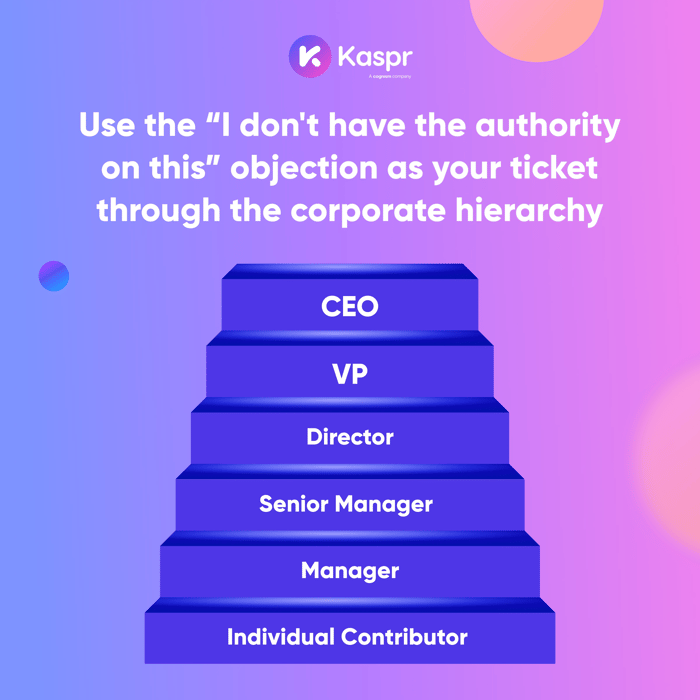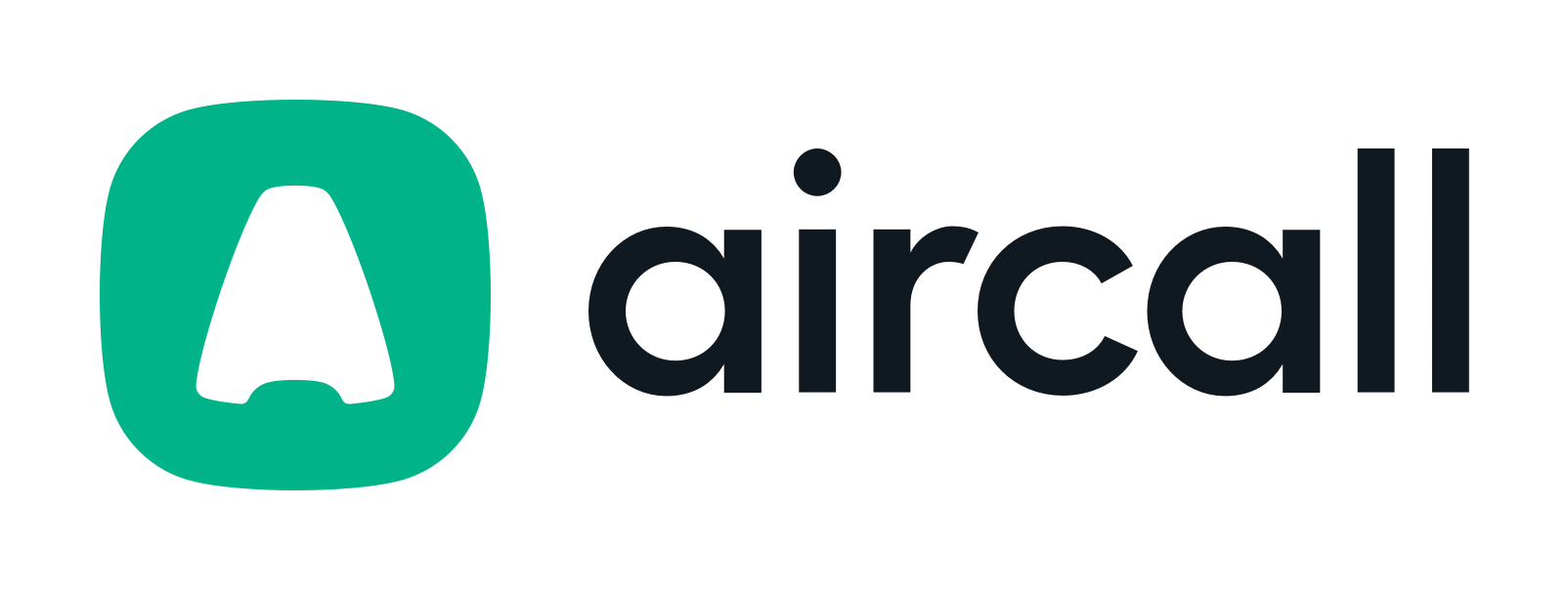
What's on this page:
How do you flip the script, turning those hard “no’s” into potential “yes’s”? It’s all about understanding the “why” behind the objection and mastering how to navigate it.
In this article, we’ll tackle cold calling objection handling with advice from top-performing reps:
- “Not the right time.”
- “We’ve already got a solution in place.”
- “I don’t have the authority on this.”
- “Can you send an email over?”
- “I am busy.”
- “We don’t have the budget for this.”
- “We’re happy with what we’ve got.”
- “How did you get my information?”
- “I hate cold calls.”
- “Who is calling? I’ve never heard of you.”
- *Hangs up.*
11 ways for cold calling objection handling
Each cold calling objection is feedback in a mask, a chance to learn more about why the prospect is pushing back. So, let’s delve into the art of objection handling, turning every ‘no’ into a ‘tell me more’.
Common objection 1: “Not the right time”
Ah, it’s one of the prospects’ most used cold-calling objections. The “Not the right time“ objection requires sales reps to try to understand why the prospect is saying it. For which there are two reasons.
Why prospects say it:
- They genuinely mean it’s not a convenient time. They could have already allocated a budget, are stuck in a contract for the next 6 months, or it isn’t high enough on the business priorities list.
- The prospect is trying to get you off the phone. “Not the right time” is also used as an evasion tactic by prospects. They don’t want to be rude and tell you no outright, so try to get you off the phone with something that sounds softer.
How to respond:
The best approach is to consider qualifying the problem behind “not the right time.” To commit to nurturing the prospect, you need a meaningful timeline to work towards.
Ask when a convenient time is. And on the call, understand what will change between now and then to make it a better time to have the conversation.
Chris Ritson, Founder of a sales coaching agency, says that from his experience, there are two areas to ask to gauge if the prospect is genuine.
These examples are specific to Chris’s industry but are easy to apply to others.
👉 Area one: The company is hiring sales development representatives now, so they will want to start training when the seats get filled.
If a company is hiring, it’s often a sign that there will soon be a budget for tools or services. For example, if you sell marketing software, you might wait to reach out until they hire the new Marketing Manager.
👉 Area two: There is a budget freeze, and X date is when they can solve this problem.
You can’t help budgets. Sometimes, it isn’t the right time because the department you’re targeting has already allocated the amount they can spend. This applies to anything, whether you’re selling training, a SaaS tool or consulting.
By asking about the details of the problem, you’ll find out if they are saying this sales objection to stop the communication.
Now, you can tell them your actions in that timeframe to stay at the top of their minds. Something like: every couple of weeks, I’ll send you something useful to help you with your right now problem.
Here’s an example of what this could sound like on a cold call from Chris:
“So I’m not going to bombard you, but every 2-4 weeks, I’ll send you something useful. You mentioned hiring is your problem right now, so I’ll send you info to help with that.”
“I’ll then send you some more training material closer to the period you mentioned and book a slot for our next conversation.”
Common objection 2: “We’ve already got a solution in place”
This objection is less a stop sign and more a yellow light, cautioning you to slow down, listen, and proceed.
Why prospects say it:
- Comfort with the current solution. Change is tough. Many prospects cling to their current solutions because they’re familiar, even if it’s not perfect. It’s less risky to stay with what you know than to switch it up.
- Lack of awareness. Sometimes, your potential customers don’t know what they’re missing. They might not be aware of your solution’s unique benefits over their existing one.
- Skepticism about the benefits. They hear your pitch, but, they think, “Is this really better, or more sales talk?” They need concrete proof that what you’re offering is significantly better.
How to respond:
Instead of launching into why your product is the best, get them curious. Ask open-ended questions about their satisfaction with the current solution.
Ivana Ivanova, Account Manager at Cognism, sees this objection as the moment to shift from defense to dialogue. She says, “This is a great opportunity to start a conversation. You get a chance to compare your solution to their current setup.”
Ivana’s strategy asks prospects to rate their experience with their current solution on a scale of 1 to 10. Rarely do you have people answer saying 10, which then means you may ask:
“What’s missing? What would make it a 10? What features do they not offer that would help increase that score?”
By identifying these gaps, Ivana isn’t just selling. She’s consulting, advising, and, most importantly, solving problems. This approach uncovers the prospect’s pain points and positions her solution as the remedy they hadn’t considered before.
Common objection 3: “I don’t have the authority on this”
This objection can open up new ways to reach the decision-makers with the right approach. It turns a potential setback into a chance to get through the organization’s hierarchy quickly.
Why prospects say it:
- Genuine lack of decision-making power. Sometimes, you really are talking to someone who doesn’t have the final say. They’re interested, but they’re not the ones signing the checks.
- Deflecting to avoid further discussion. This objection can be a convenient escape route for someone not interested in continuing the conversation. It’s an easy out.
- Uncertainty about the product. Occasionally, potential customers use this as a pause button. They need clarification and more information on your offer before championing it to higher-ups.
How to respond:
Start with understanding. Then, gently ask if they can direct you to the right person:
“Absolutely. I understand that these decisions often involve several different people. Would it be possible for you to point me in the direction of who oversees these decisions?”
If they show genuine interest, arm them with information and turn them into a champion:
“What information can I provide you with to help discuss this further internally?”
When you find the phone number of the right person and get them on the line, you’ll not be cold-calling anymore. You’ll step in with a warm intro. How cool is that? Here’s a smooth way to roll into the conversation:
“I gave (name) a ring earlier today, and they said you’d be the best person to speak to about this.”
It’s casual, respectful, and shows you’re not shooting in the dark - you’ve done your homework. Plus, it subtly establishes a mutual connection, which makes the conversation feel more like a warm handoff than a cold pitch.

Common objection 4: “Can you send an email over?”
David Bentham, VP of Global Sales Development at Cognism, says his sales team makes 20,000+ cold calls monthly. Of those 20K+ calls, the objection “Can you put it in an email?” is one of the most common.
Why prospects say it:
- Seeking a polite exit. It’s a non-confrontational way to wrap up the call, especially if your pitch does not immediately catch their attention.
- Genuine interest for later review. Some prospects prefer digesting information at their own pace, making an email a preferred option.
- Need for more details. They might be intrigued but need detailed info best absorbed in written form.
How to respond:
To handle this objection, David proposes to use a framework “Listen, Ask, Solve, Confirm”:
- Listen - acknowledge and understand the objection.
- Ask - ask an open-ended question to uncover the true reason for the objection.
- Solve - based on the answer given, offer them a solution.
- Confirm - validate the solution meets the potential client’s requirements.
Here’s how it works in practice:
Prospect: Can you put it in an email?
✅ Listen and acknowledge
SDR: Yes, I can absolutely send you an email on this.
✅ Ask
SDR: Can you confirm exactly what you want to see in that email?
Prospect: I’d like to learn more about pricing and compliance. Maybe include some case studies?
✅ Solve
SDR: I can do this. But since there is a lot of information to cover in the email, and instead of sending over something generic, can I suggest it would be easier to talk this through? Totally understand I caught you out of the blue today, but let’s find time later in the week.
✅ Confirm
SDR: Do you have your calendar in front of you?
Instead of accepting defeat and ending the call, this framework lets you dissect objections in sales calls. You can then diffuse it by offering an alternative.
Common objection 5: “I am busy”
The phrase “I am busy” often serves as a quick, polite, or sometimes abrupt way to put a conversation on ice. Yet, this doesn’t always have to signal the end.
Why prospects say it:
- Honest time constraints. Sometimes, you catch potential customers at a genuinely bad time. They’re swamped, busy people and feel like they can’t spare a moment.
- A reflexive response to cold calls. Often, “I’m busy” is a defense mechanism against unsolicited phone calls. It’s a polite way to fend off what they perceive as an interruption.
- Uncertain interest. At times, this objection masks uncertainty about the conversation’s value. It’s a soft way of saying, “Convince me this is worth my time.”
How to respond:
Chris Ritson, a Co-founder of The SDR Leader, describes the prospect’s reaction to a cold call as a “fight or flight” response. It’s like tuning into the primal instincts that kick in when someone senses an unexpected intrusion, which, in this context, is your call.
When a prospect is in fight mode, they’re defensive. They’re ready to challenge your presence on the line with questions like “Who is calling?”, “Where are you calling from?” and the classic “Are you a salesperson?”.
They’re ready to protect their territory (their time and attention) from a perceived threat (the sales pitch).
On the flip side, flight mode is about evasion. Prospects are seeking quick escape routes. They might say, “We have something,” or “I thought you were someone else.” These are their smoke bombs. They create a quick diversion to exit the conversation swiftly.

The “I’m busy” objection is a classic example of the flight mode response. In this situation, Chris advises making the prospects feel understood.
For instance, if a prospect says they’re in a meeting, Chris suggests a response that combines acknowledgment with an invitation to engage:
“Got it. So you know, I’m Chris, an SDR at CRsales. Is it fair to grab 30 seconds to explain why I called, and then you can decide if we should do another call when you aren’t busy?”
This approach lets the prospect see your conversation’s value and sets the stage for a potential follow-up call.
Common objection 6: “We don’t have the budget for this”
This objection is a signal to reassess. Approach the conversation with a mindset focused on long-term investment.
Why prospects say it:
- Real budget constraints. The prospect’s budget may truly be allocated, and there’s no current flexibility.
- Perceived lack of value. The prospect doesn’t see the immediate value outweighing the cost.
- Delaying decision. Sometimes, it’s saying “no“ without ending the conversation. In a buyer journey, they stay in the awereness stage, not ready to move to the consideration phase.
How to respond:
David Bentham, VP of Global Sales Development at Cognism, has a refined strategy for tackling this type of objection.
His method involves a solution-oriented mindset. Based on what you’ve learned about the prospect’s challenges, give them a reason to reallocate their budget or plan for future investment.
Here’s an example of what this could sound like on an outbound sales call from David:
“You told me you’re struggling to reach decision-makers - can I show you how we can fix this over a 15-minute call? That way, you've reviewed the platform, and you can consider it when the time is right.”
Common objection 7: “We’re happy with what we’ve got”
“We’re happy with what we’ve got“ objection is an invitation to explore your prospect’s satisfaction more. This will help you position your offering as an addition or potential upgrade.
Why prospects say it:
- Real satisfaction. They might truly be content with their current solution and see no reason to change.
- Financial risk aversion. People fear change. Staying with the familiar seems safer than risking a new product or service.
- Their reputation. No one wants to implement a solution everybody hates. Remember, a prospect’s rep is on the line when they switch up their tech stack.
How to respond:
Chris Ritson, an expert in outbound sales strategies, has three ways to handle objections in sales calls: mirroring, labeling, and asking clarifying questions.
✅ Mirroring: Use the prospect’s own words to encourage them to elaborate. If they say, “We’re not exploring new options,” you might mirror, “Not exploring new options?”.
This prompts the prospect to give more detail, which helps you understand their situation and how to address their concerns.
✅ Labeling: Show empathy and understanding. Acknowledge statements with, “It sounds like you’re quite content with your current setup".
This validation often lowers defenses, making the prospect more open to conversation.
✅ Clarifying questions: Instead of pitching, ask questions like, “What features of your current system do you value the most?”.
This shows you care about their needs. It also helps find gaps where your solution could add value, allowing you to use value-based selling principles.
Common objection 8: “How did you get my information?”
This objection stems from a need for privacy and control over personal information. To maintain trust and credibility, address it directly, respectfully, and without hesitation.
Why prospects say it:
- Privacy concerns. In an era where data privacy is critical, people are cautious about their data.
- Surprise or suspicion. Receiving a call from an unknown sales representative is jarring. Prospects may be suspicious of unsolicited contact.
- Desire for control. They want to ensure they control who has their information and why.
How to respond:
David Bentham, VP of Global Sales Development at Cognism, suggests a straightforward and honest approach. If the prospect responds negatively, tell the truth about where you got their number. Then, identify a channel to continue the conversation.
Example of the response from David:
“I got your number from Cognism, who is our B2B contact data provider. What would be the preferred method of communication moving forward?”
💡 Tip: Kaspr is a B2B data provider too! Check out our phone numbers to reach more decision-makers when cold calling.
Common objection 9: “I hate cold calls”
When a prospect bluntly states, “I hate cold calls,” it’s your cue to step away from the standard cold calling script.
👉 You might like this: Build your outbound lead generation strategy.
Why prospects say it:
- Past negative experiences. They’ve likely been bombarded with calls that offered little value or relevance to them.
- Lack of personalization. Many cold calls fail to address the prospect’s unique needs or interests, leading to frustration.
- The perception of the sleazy salesperson. There are often misconceptions about salespeople. Unfortunately, it means that lots of people aren’t open to speaking with them, particularly when it takes time out of their day.
How to respond:
Brad Norgate, a Senior Enterprise SDR at Cognism, flips the script by directly addressing their distaste for cold calls. Here’s what Brad’s answer sounds like:
“Why do you hate cold calls so much? You’ve had a bad experience?”
Pay close attention to their response. It can reveal valuable information about their expectations and past experiences. Acknowledge their feelings. Assure them that you aim to provide value, not frustration.
Common objection 10 “Who is calling? I’ve never heard of you.”
This question often shows the prospect weighing the pros and cons of the conversation: Does it deserve their time?
They are not asking you to repeat your name; they want more context to help them judge the situation.
Why prospects say it:
- Filtering out noise. Prospects use this question to filter meaningful opportunities from distractions.
- Assessing importance. They’re deciding if your call should be a business priority based on the immediate relevance to their needs.
- Understanding your role. Knowing your position and expertise helps them understand the potential value of the conversation.
How to respond:
Remember Chris Ritson’s strategy of dividing common sales objections into ‘fight’ and ‘flight’ responses, which we mentioned earlier? Now, we see a perfect example of the ‘fight’ response.
‘Fight’ is a pushback. The prospect says, “I don’t know you, and I don’t trust you, YET.”
To respond to ‘fight,’ repeat your cold call opener with more context.
Example:
Opener: “Hey John, It’s Chris calling from CR sales. Got 30 seconds to tell you why I called?”
Prospect: “Who is calling? I’ve never heard of you.”
Repeat opener with context: Chris Ritson, I’m an SDR at CRSales. We help CEOs like you with X. Like I said, could I get 30 seconds to tell you why I’ve called?”
Common objection 11: *Hangs up*
After you encounter hanging up, the next move is crucial. It will determine whether you open the door to a future conversation or close it for good.
Why prospects do it:
- Lack of interest. They may not see immediate value in the conversation.
- Bad timing. You could have caught them at an inconvenient moment.
- Overwhelmed. They might be feeling overwhelmed by sales calls and react by ending the call abruptly.
How to respond:
Jeff Bradford, a seasoned PR expert, says the best action when someone hangs up on you is to call them back immediately.
When redial, keep it light and professional. Imagine it’s a simple glitch, “Oh, looks like we got disconnected,” you’d say with a touch of surprise, not a hint of accusation. It’s all about giving them an out, easing any awkwardness.
In this second attempt, shifting gears from selling to serving is essential. Offer to email the potential client some useful information from which you, the cold caller, derive no gain and then hang up.
Jeff highlights that it is essential that whatever you provide via email has zero sales content for this tactic to work. This will show your commitment to their needs rather than your sales targets.
This generosity can surprise and engage them. It will set a positive tone for when you reach out again in a couple of days.
/EN_hang-ups-cold-call-graphic.webp?width=700&height=700&name=EN_hang-ups-cold-call-graphic.webp)
Make sure you understand your no’s
Understanding the type of “no” you hear on a call will help you to use it as a stepping stone toward your next successful outbound sales call.
No matter how worded, all objections fit into four types of ‘no’s. It is useful to categorize your ‘no’s’ so you understand how to approach each one.
Shabri Lakhani, Strategic Advisor at Kaspr, talks about the four categories that can give you a clearer picture of your prospect’s stance and how to tailor your approach.
First no: “Not me.”
You’ve possibly got the wrong person on the line. See it as a directional sign pointing you to the right contact within the organization. Ask, “Who would be the best person to discuss this with?” You could even grab a referral while you’re at it.
Second no: “Not now.”
What you do here is crucial: dig deep, find out their timeline, understand their current focus, and keep nurturing that lead. Serve up content that hits at the heart of their current challenges. When the time is ripe, you’ll be top of their mind.
Third no: “Not you.”
It’s often about competition. This is your moment to shine with curiosity. Asking what they like about their current solution can reveal gaps you can fill. It’s important not to be too negative about the current solution. This isn’t a good look and puts them back on the defensive.
Forth no: “Not ever.”
If this one comes up, it’s time to reflect. Are you really reaching out to the right ICP? If so, is your message relevant to them? Make sure you’re targeting the right person. Then, evaluate your delivery and messaging.
Call prospects now with Kaspr
Don’t let objections in sales calls be the end of the road. Sign up now to use Kaspr and immediately access accurate phone numbers of decision-makers. No card details are needed.
You will also get features to optimize outbound lead generation:
✅ 500M+ phone numbers and email addresses.
✅ Integrate with popular CRM systems.
✅ Dial directly from the web app.
✅ Use custom plans to meet your specific requirements.
✅ Use analytics to track ROI and optimize performance.
✅ GDPR and CCPA aligned.
Kaspr is here to help you overcome cold call objections and achieve your sales goals faster. Are you ready to step up your cold-calling game?
Accurate European contact data
Get accurate data for your prospects and connect with your favorite sales tool









